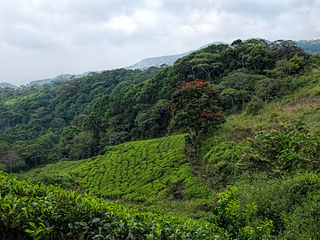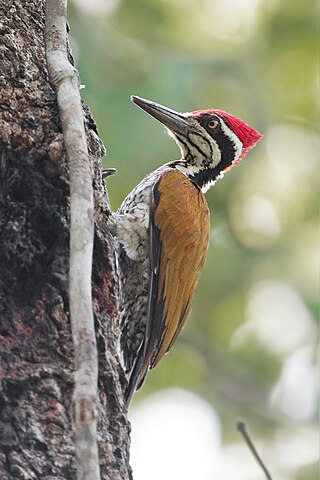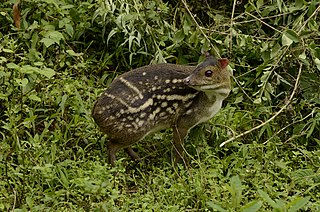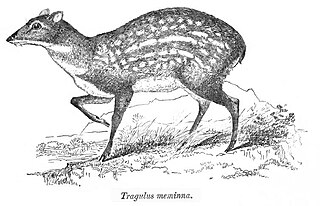
The rusty-spotted cat is one of the cat family's smallest members, of which historical records are known only from India and Sri Lanka. In 2012, it was also recorded in the western Terai of Nepal. Since 2016, the global wild population is listed as Near Threatened on the IUCN Red List as it is fragmented and affected by loss and destruction of its prime habitat, deciduous forests.

Chevrotains, or mouse-deer, are diminutive, even-toed ungulates that make up the family Tragulidae, and are the only living members of the infraorder Tragulina. The 10 extant species are placed in three genera, but several species also are known only from fossils. The extant species are found in forests in South and Southeast Asia; a single species, the water chevrotain, is found in the rainforests of Central and West Africa. They are solitary, or live in loose groupings or pairs, and feed almost exclusively on plant material. Chevrotains are the smallest hoofed mammals in the world. The Asian species weigh between 0.7 and 8.0 kg, while the African chevrotain is considerably larger, at 7–16 kg (15–35 lb). With an average length of 45 cm (18 in) and an average height of 30 cm (12 in), the Java mouse-deer is the smallest surviving ungulate (hoofed) mammal, as well as the smallest artiodactyl. Despite their common name of "mouse deer", they are not closely related to true deer.

Horton Plains National Park is a national park in the central highlands of Sri Lanka that was designated in 1988. It is located at an elevation of 2,100–2,300 m (6,900–7,500 ft) and encompasses montane grassland and cloud forest. It is rich in biodiversity and many species found here are endemic to the region. It is also a popular tourist destination and is situated 8 kilometres (5.0 mi) from Ohiya, 6 kilometres (3.7 mi) from the world-famous Ohiya Gap/Dondra Watch and 32 kilometres (20 mi) from Nuwara Eliya.

Sinharaja Forest Reserve is a forest reserve and a biodiversity hotspot in Sri Lanka. It is of international significance and has been designated a Biosphere Reserve and World Heritage Site by UNESCO.

The greater flameback, also known as the greater goldenback or large golden-backed woodpecker, is a woodpecker species. It occurs widely in the northern Indian subcontinent, eastwards to southern China, the Malay Peninsula, Sumatra, western and central Java and northeast Borneo.

The spot-bellied eagle-owl, also known as the forest eagle-owl is a large bird of prey with a formidable appearance. It is a forest-inhabiting species found in the Indian Subcontinent and Southeast Asia. This species is considered part of a superspecies with the barred eagle-owl, which looks quite similar but is allopatric in distribution.

The Indian spotted chevrotain is a species of even-toed ungulate in the family Tragulidae. It is native to India and possibly Nepal. It lives in rainforests and is nocturnal. It has a body length of 57.5 cm (22.6 in) with a 2.5 cm (0.98 in) long tail length and weighs around 3 kg (6.6 lb). This was earlier included under the name of Tragulus meminna, but studies on the systematics of the group have led to that name being restricted to the Sri Lankan spotted chevrotain.

Moschiola, the spotted chevrotains, are a genus of small even-toed ungulates in the family Tragulidae. They are found in forests in India, Sri Lanka and perhaps Nepal, and have pale-spotted or -striped upperparts unlike the other Asian members of the family, the mouse-deer of the genus Tragulus.

The yellow-striped chevrotain is a species of chevrotain described in 2005. It is found in the wet zones of Sri Lanka. It was recognized as a species distinct from Moschiola meminna based on the phylogenetic species concept.

The tufted gray langur, also known as Madras gray langur, and Coromandel sacred langur, is an Old World monkey, one of the species of langurs. This, like other gray langurs, is mainly a leaf-eating monkey. It is found in southeast India and Sri Lanka. It is one of three Semnopithecus species named after characters from The Iliad, S. hector and S. ajax being the others. In Sinhala it is known as හැලි වදුරා.

Lunugamvehera National Park in Sri Lanka was declared in 1995, with the intention of protecting the catchment area of the Lunugamvehera reservoir and wildlife of the area. The national park is an important habitat for water birds and elephants. The catchment area is vital to maintain the water levels of the five tanks in the down stream of Kirindi Oya and wetland characteristics of Bundala National Park. This national park also serves as a corridor for elephants to migrate between Yala National Park and Udawalawe National Park. The national park is situated 261 km (162 mi) southwest from Colombo. After being closed because of the Sri Lankan civil war, the national park is now open to the general public.
Flood Plains National Park is one of the four national parks set aside under the Mahaweli River development project in Sri Lanka. The park was created on 7 August 1984. The national park is situated along the Mahaweli flood plain and is considered a rich feeding ground for elephants. Flood Plains National Park is considered an elephant corridor for the elephants migrate between Wasgamuwa and Somawathiya national parks. The park is situated 222 kilometres (138 mi) north-east of Colombo.
Madhu Road National Park is a national park in northern Sri Lanka, approximately 25 km (16 mi) east of Mannar.

Piyavi Wijewardene is a Sri Lankan researcher, lecturer, author. He is the Vice President and Chief Executive Officer of the Odiliya Group. In addition he serves as the Director Quality Assurance at KIU Sri Lanka. He is the former Director of Institute of Human Capital Development and one of the Examiners at Sri Lanka Institute of Development Administration. He is a member of the Academy for Global Business Advancement and the Chapter President, Sri Lanka at the International Management Research and Technology Consortium. He served as the Head of Academics at the Management and Science University. He was instead worked as an executive officer at the Capital Maharaja Organization.













